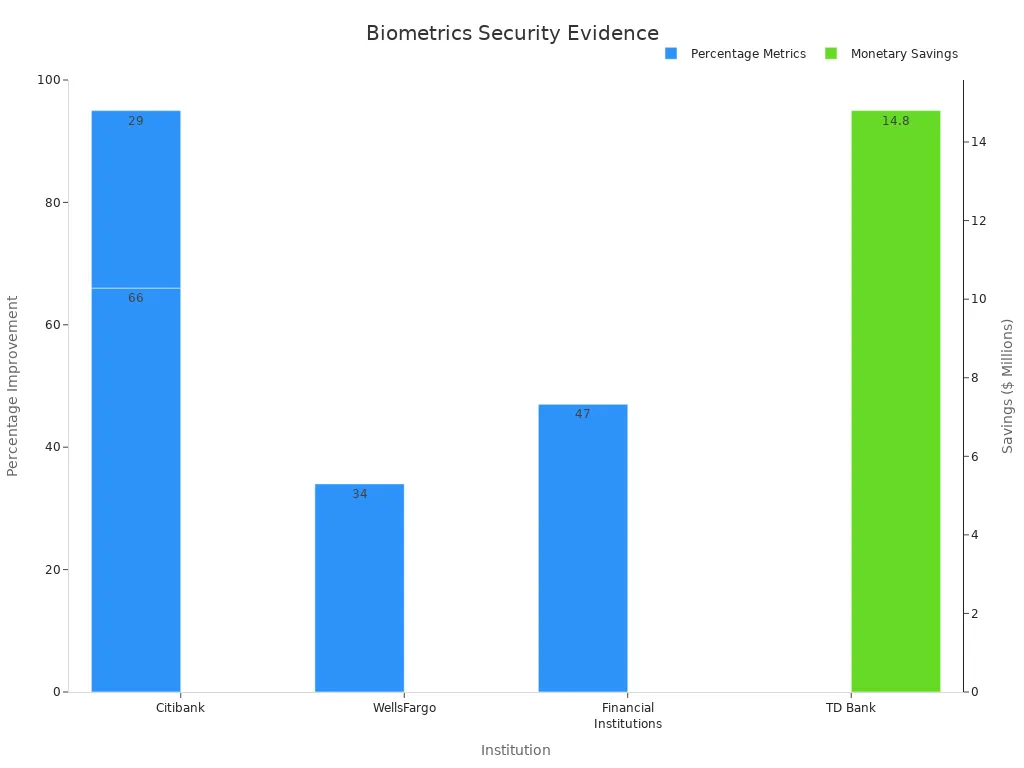
In 2025, AI transforming financial fraud detection has become a reality. Banks now report up to a 98% success rate in identifying fraud, thanks to real-time monitoring and generative AI.
Customers benefit from faster, more accurate protection and improved trust.
Key Takeaways
-
AI helps find fraud by checking transactions right away. It spots strange actions fast and lowers false alarms.
-
Banks use behavior checks and smart computers to fight new tricks. This saves money and makes customers trust banks more.
-
Banks have problems with data and rules. But they must keep trying new ideas to stop changing fraud.
AI Transforming Fraud Detection
Real-Time Monitoring
Financial institutions now rely on AI transforming their fraud detection strategies through real-time monitoring. AI systems analyze massive transaction datasets instantly, identifying suspicious activity as it happens. This immediate response marks a significant improvement over traditional, rule-based systems, which often lag behind fast-moving threats.
Real-time monitoring enables banks to spot unusual patterns, such as transactions from unexpected locations or at odd hours, that might escape human notice.
AI transforming fraud detection delivers several key advantages:
-
AI processes vast financial data in real time, detecting suspicious transactions as they occur.
-
It uncovers hidden fraud patterns by correlating multiple data points, such as login times and transaction locations.
-
Machine learning models adapt quickly to new fraud tactics, unlike static systems.
-
AI reduces false positives by evaluating transactions in context, minimizing unnecessary disruptions for customers.
-
Automated data analysis allows human investigators to focus on high-risk cases and strategic decisions.
-
Companies like PayPal have reported significant reductions in fraudulent transactions after adopting AI.
-
AI systems scale to handle growing transaction volumes without losing speed or accuracy.
-
Automated flagging of suspicious activities supports compliance with regulations like AML and KYC.
-
The AI-driven investigation process includes data gathering, cleaning, anomaly detection, risk scoring, human review, and continuous learning.
Machine Learning & Generative AI
Machine learning and generative AI models play a crucial role in adapting to evolving fraud tactics. Fraudsters constantly develop new methods, including adversarial inputs, prompt injections, and jailbreaking, to bypass security systems. AI transforming fraud detection means these advanced models can learn from new data and adjust their defenses rapidly.
Recent studies in the banking sector show that combining rule-based machine learning with generative AI, such as deep-learning networks and large language models, improves anomaly detection and credit risk assessment. This hybrid approach enables real-time analysis of large data volumes, reducing false positives and financial losses. Integration of these AI tools into banking workflows also enhances employee readiness and overall effectiveness.
Large language models like ChatGPT have introduced new challenges. They allow attackers to craft highly personalized phishing messages by analyzing digital footprints. These sophisticated social engineering attacks require adaptive AI-based countermeasures. As fraud tactics grow more complex, AI systems must continuously evolve to stay ahead.
Behavioral Biometrics
Behavioral biometrics add another layer of security by analyzing unique user behavior patterns. AI systems monitor factors such as typing speed, mouse movements, and navigation habits to create behavioral profiles. When a user’s behavior deviates from their established profile, the system flags potential fraud or account takeover attempts.
This proactive approach provides continuous authentication and anomaly detection, improving fraud prevention. Financial institutions have reported measurable benefits:
|
Institution |
Security Improvement Metric |
Outcome Description |
Source/Year |
|---|---|---|---|
|
Citibank |
Significant reduction in fraudulent account takeovers |
Citibank Security Report, 2023 |
|
|
Citibank |
29% reduction in false fraud alerts |
Improved operational efficiency and fewer false positives |
Citibank Security Report, 2023 |
|
Wells Fargo |
34% increase in mobile banking satisfaction scores |
Enhanced customer experience linked to biometric authentication |
Wells Fargo Customer Experience Index, 2023 |
|
TD Bank |
$14.8 million annual savings |
Cost savings primarily from reduced fraud losses and lower operational costs |
TD Bank Annual Report, 2022 |
|
Financial Institutions (general) |
47% average reduction in fraudulent transactions |
Measurable security improvement within first year of biometric implementation |
Forrester Research, 2023 |

Behavioral biometrics, integrated with AI, lead to significant fraud reduction, operational cost savings, and improved customer trust. These technologies ensure that financial institutions can offer secure and seamless experiences for their customers.
Benefits & Impact
Accuracy & False Positives
AI transforming financial fraud detection delivers measurable improvements in accuracy and a significant reduction in false positives. Financial institutions now rely on advanced AI models that analyze transaction patterns and customer behavior to refine alert thresholds. These systems identify low-risk transactions, allowing teams to focus on real threats.
-
HSBC’s AI system reduced false positives by 60% while detecting two to four times more suspicious activities. The system analyzes 1.35 billion transactions monthly and speeds up review times from weeks to days.
-
Danske Bank replaced rule-based systems with AI, achieving a 60% reduction in false positives and a 50% increase in true fraud detection. This shift saved millions in losses and investigation costs.
-
Mastercard’s generative AI doubled detection rates of compromised cards and reduced false declines by up to 200%. The company also tripled the speed of identifying at-risk merchants.
-
Adaptive learning and real-time anomaly detection allow AI to evolve with new fraud tactics, maintaining high precision and reducing false alarms.
-
Human-AI collaboration ensures that analysts verify AI-generated alerts, combining speed with expert judgment.
|
Domain / Use Case |
Quantitative Improvement |
Metric Type |
|---|---|---|
|
Threat Identification |
Accuracy improvement |
|
|
Fraud Detection |
False positive reduction |
|
|
Insurance Claims Processing |
Claim processing time reduced from 5 days to 2 days |
Operational efficiency |
Generative AI enhances fraud detection by enabling real-time anomaly detection and adaptive learning. These capabilities help financial institutions detect subtle anomalies in transaction patterns faster and more accurately than traditional methods. As a result, organizations experience fewer false alarms and better fraud prevention.
Customer Trust
AI transforming fraud detection not only improves security but also strengthens customer trust. Customers now experience fewer declined transactions and enjoy a seamless banking experience. Predictive analytics and biometric authentication play a key role in this transformation.
-
Customer satisfaction scores related to digital banking increased by 23% after implementing AI-driven biometric authentication.
-
91% of customers report feeling more secure when using biometric authentication.
-
64% of customers cite biometric authentication as a key factor in choosing or remaining with their bank.
-
HSBC’s voice biometrics implementation achieved 95% customer satisfaction.
-
Fraud incidents reduced by an average of 66% within 12 months of biometric system deployment.
-
Mobile banking engagement increased by 34%, and authentication-related support calls dropped by 27%.
AI-powered fraud detection reduces false positives, ensuring legitimate transactions are not wrongly flagged. This improvement boosts customer loyalty and trust. Real-time monitoring detects suspicious activity instantly, reassuring customers about account security. Transparency in AI processes further increases confidence.
Financial institutions that adopt AI-driven fraud prevention see measurable improvements in customer relationships. Enhanced identity verification and continuous learning maintain a balance between tight security and smooth customer transactions.
Case Studies
Several leading organizations have demonstrated the transformative impact of AI in financial fraud prevention.
-
JP Morgan Chase reduced false positives by 50% and improved fraud detection by 25% after adopting AI. The bank also achieved significant cost savings and enhanced customer trust.
-
Progressive uses AI-driven machine learning to analyze thousands of claims daily, improving fraud detection accuracy and investigation efficiency.
-
Allstate employs real-time machine learning algorithms to assess fraud likelihood during claims processing, streamlining legitimate claims and enhancing risk mitigation.
-
Chubb utilizes AI-based data modeling, including social media and public records, to detect fraud signs and improve risk assessment.
|
Metric / Outcome |
Result / Statistic |
|---|---|
|
Reduction in false positives |
50% |
|
Improvement in fraud detection rates |
60% |
|
Reduction in fraudulent transactions |
Up to 70% |
|
Projected AI adoption in financial sector |
80% by 2024 |
|
Expected cost savings from AI adoption |
$31 billion by 2025 |
|
Increase in customer trust |
30% |
|
Increase in AML compliance |
40% |
These case studies highlight the broad impact of AI transforming fraud detection. Organizations benefit from enhanced accuracy, faster processing, and significant cost savings. The adoption of AI in fraud prevention continues to grow, with financial institutions reporting improved compliance, reduced losses, and stronger customer relationships.
Challenges & Future Trends

Data & Integration
Financial institutions face significant hurdles in data quality and integration when deploying AI for fraud detection. AI systems require vast amounts of accurate, up-to-date data. Incomplete or outdated information can lead to missed fraud or false positives, undermining trust in AI solutions. Integrating data from multiple sources, especially legacy systems, often proves complex and resource-intensive. Privacy laws add another layer of difficulty, as organizations must balance data access with strict compliance requirements.
|
Challenge Aspect |
Description |
|---|---|
|
Combining and standardizing data from multiple sources is complex and time-consuming. |
|
|
Poor Data Quality |
Low-quality data blocks AI algorithms, resulting in ineffective fraud detection. |
|
Integration with Legacy Systems |
Integration can be complex and resource-intensive, causing potential operational disruptions. |
|
Data Consistency and Accuracy |
Ensuring completeness and accuracy is critical to avoid false positives or missed fraud. |
|
Privacy and Regulatory Balance |
Balancing data availability with privacy and compliance complicates integration efforts. |
Compliance & Ethics
Regulatory compliance and ethical standards present ongoing challenges. Financial organizations must navigate complex rules such as AML, KYC, and GDPR. Recent cases, including fines for improper data use and algorithmic bias, highlight the risks of non-compliance. For example, the EU AI Act imposes heavy penalties for violations, while incidents like the Dutch Tax Authority’s biased fraud detection system show the social impact of unfair AI. Companies must ensure transparency, fairness, and accountability in their AI models to maintain public trust.
Note: Algorithmic bias, lack of transparency, and third-party risks remain top concerns for regulators and industry leaders.
Future Outlook
AI will continue to transform fraud detection, but new threats will emerge. Experts predict a surge in synthetic identity fraud and AI-powered impersonation attacks. Financial losses from digital fraud are expected to exceed $47.8 billion this year. At the same time, advancements in explainable AI and biometrics will enhance detection and compliance. Financial institutions must invest in continuous innovation and adapt quickly to evolving fraud tactics to stay ahead.
|
Aspect |
Projection/Statistic |
|---|---|
|
Synthetic identity fraud |
31% increase expected in 2025 |
|
AI-powered impersonation |
Attacks expected to double year-over-year |
|
AI adoption in fraud defense |
51% of organizations now use AI for fraud prevention |
AI transforming financial fraud detection in 2025 delivers real-time analysis, adaptive learning, and improved accuracy. Key trends include instant payments, deepfake scams, and rising check fraud.
-
52% better detection reported by most institutions
-
Continuous updates and collaboration keep defenses strong
Staying proactive ensures organizations outpace evolving threats.
FAQ
What types of fraud can AI detect in 2025?
AI detects payment fraud, account takeovers, synthetic identities, and phishing attacks. It also identifies insider threats and unusual transaction patterns across digital banking platforms.
How does AI reduce false positives in fraud detection?
AI uses adaptive learning and behavioral analysis. These methods help systems distinguish between legitimate and suspicious activities, which lowers the number of false alerts for customers.
Is customer data safe when banks use AI for fraud detection?
Banks use encryption and strict access controls. They follow privacy regulations to protect customer data during AI-driven fraud detection processes.
